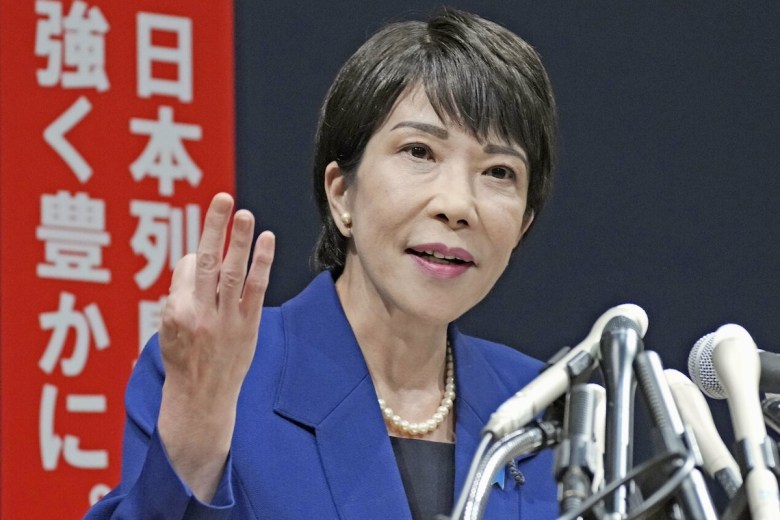Politics
Takaichi’s Leadership Marks New Era for Japan and Global Politics

TOKYO — Sanae Takaichi is poised to become Japan’s first female Prime Minister, a development that promises significant implications for both the nation and the international community. With the backdrop of ongoing global shifts due to Donald Trump’s trade policies and China’s rising influence, Takaichi’s conservative approach introduces a new dynamic to Japan’s political landscape.
Takaichi, 64, has indicated a desire to renegotiate the tariff deal established by outgoing Prime Minister Shigeru Ishiba with President Trump. Known for her critical stance on China, she frequently visits Yasukuni Shrine, which honors Japan’s war dead. Her leadership has raised eyebrows among international leaders, with Trump’s team reportedly on alert and Xi Jinping likely uneasy about her ascension as leader of the Liberal Democratic Party (LDP).
While Takaichi’s historic rise is celebrated, it is complicated by her positions on various social issues. She has opposed allowing married couples to have separate surnames, a change long sought by many in Japan. Furthermore, her reluctance to support same-sex marriage and dismissive attitude towards a female ascension to the Chrysanthemum Throne highlight her conservative stance, which diverges from the progressive aspirations some had hoped for.
Despite these views, Takaichi has committed to narrowing Japan’s gender gap, promising to appoint enough women to her Cabinet to align with the representation seen in Nordic countries. This ambition echoes the past promises made by her political mentor, the late Shinzo Abe, who introduced Abenomics to revitalize Japan’s economy. The central goal of his economic strategy was to empower women within a workforce of approximately 125 million.
Historically, the underutilization of female talent has been highlighted by leading economists, including Kathy Matsui. Research from organizations such as the International Monetary Fund and the World Bank indicates that increasing female participation in the workforce could significantly boost Japan’s GDP. However, despite earlier commitments, Japan’s ranking in the World Economic Forum gender equality index has declined from 101st to 118th out of 148 countries.
As Takaichi prepares to take office, she faces immediate challenges related to Japan’s economic outlook. The country’s projected growth rate for the fiscal year stands at a mere 0.7%, with recent data indicating an increase in the unemployment rate to 2.6%, the highest in 13 months. According to Stefan Angrick, head Japan economist at Moody’s Analytics, the labor market is showing signs of weakness, with a downward trend in active job openings and a decrease in working hours.
Angrick notes that the combination of a sluggish domestic economy, uncertainty surrounding U.S. tariffs, and inflationary pressures are likely to impede any immediate improvement in employment conditions. The trade agreement reached in July, which sets a 15% tariff rate, is expected to detract from GDP by at least 0.5%, further complicating Takaichi’s economic agenda.
As Takaichi assumes leadership, she will likely also face pressure to continue the fiscal stimulus approaches of Abenomics, which have left Japan with a significant debt burden currently sitting at 260% of GDP. With the LDP lacking control over both houses of parliament, Takaichi will need to negotiate with opposition parties to form a coalition government, potentially leading to tax cuts that could inflate the already high debt levels.
The political landscape will also challenge the Bank of Japan and its Governor, Kazuo Ueda. Takaichi’s previous criticisms of the Bank’s monetary policies may lead to tensions as she advocates for reduced interest rates while Ueda pursues a path of gradual tightening.
Takaichi’s approach to foreign relations will also be scrutinized, particularly regarding her stance on the U.S.-Japan trade deal. She has expressed dissatisfaction with Ishiba’s agreement, specifically criticizing the US$550 billion “signing bonus” demanded by Trump. Her comments suggest a willingness to renegotiate terms that do not favor Japan, indicating a potentially confrontational relationship with the U.S. leader.
As the world watches, Takaichi’s leadership is set to unfold against a backdrop of economic challenges and shifting geopolitical alliances. With significant expectations ahead, her ability to navigate these complex issues will be critical for Japan’s future.
-

 Lifestyle4 months ago
Lifestyle4 months agoHumanism Camp Engages 250 Youths in Summer Fest 2025
-

 Business5 months ago
Business5 months agoKenvue Dismisses CEO Thibaut Mongon as Strategic Review Advances
-

 Sports4 months ago
Sports4 months agoDe Minaur Triumphs at Washington Open After Thrilling Comeback
-

 Sports5 months ago
Sports5 months agoTupou and Daugunu Join First Nations Squad for Lions Clash
-

 Top Stories5 months ago
Top Stories5 months agoColombian Senator Miguel Uribe Shows Signs of Recovery After Attack
-

 World5 months ago
World5 months agoASEAN Gears Up for Historic Joint Meeting of Foreign and Economic Ministers
-

 Health4 months ago
Health4 months agoNew Study Challenges Assumptions About Aging and Inflammation
-

 Business5 months ago
Business5 months agoOil Prices Surge Following New EU Sanctions on Russia
-

 Entertainment4 months ago
Entertainment4 months agoDetaşe-Sabah Violin Ensemble Captivates at Gabala Music Festival
-

 Entertainment4 months ago
Entertainment4 months agoBaku Metro Extends Hours for Justin Timberlake Concert
-

 Top Stories5 months ago
Top Stories5 months agoRethinking Singapore’s F&B Regulations Amid Business Closures
-

 Business5 months ago
Business5 months agoU.S. House Approves Stablecoin Bill, Sends to Trump for Signature









